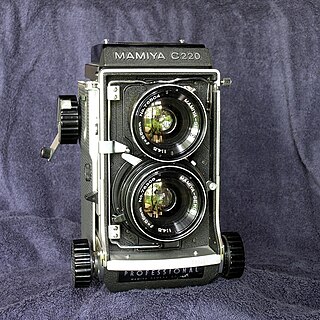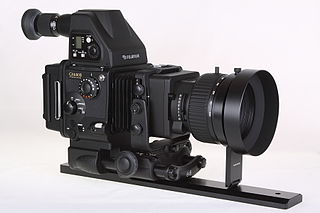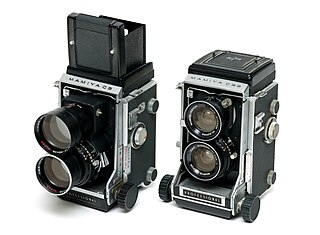
A camera is an instrument used to capture and store images and videos, either digitally via an electronic image sensor, or chemically via a light-sensitive material such as photographic film. As a pivotal technology in the fields of photography and videography, cameras have played a significant role in the progression of visual arts, media, entertainment, surveillance, and scientific research. The invention of the camera dates back to the 19th century and has since evolved with advancements in technology, leading to a vast array of types and models in the 21st century.

A rangefinder camera is a camera fitted with a rangefinder, typically a split-image rangefinder: a range-finding focusing mechanism allowing the photographer to measure the subject distance and take photographs that are in sharp focus.

A view camera is a large-format camera in which the lens forms an inverted image on a ground-glass screen directly at the film plane. The image is viewed, composed, and focused, then the glass screen is replaced with the film to expose exactly the same image seen on the screen.

A twin-lens reflex camera (TLR) is a type of camera with two objective lenses of the same focal length. One of the lenses is the photographic objective or "taking lens", while the other is used for the viewfinder system, which is usually viewed from above at waist level.

The Nikon F camera, introduced in April 1959, was Nikon's first SLR camera. It was one of the most advanced cameras of its day. Although many of the concepts had already been introduced elsewhere, it was revolutionary in that it was the first to combine them all in one camera. It was produced until October 1973 and was replaced by the Nikon F2. Aspects of its design remain in all of Nikon's subsequent SLR cameras, through the current Nikon F6 film and Nikon D6 digital models. The "F" in Nikon F was selected from the term "re-f-lex", since the pronunciation of the first letter "R" is not available in many Asian languages. That tradition was carried all the way through their top line of Nikon cameras until the introduction of the Nikon D1 (digital) cameras decades later.

Rollei was a German manufacturer of optical instruments founded in 1920 by Paul Franke and Reinhold Heidecke in Braunschweig, Lower Saxony, and maker of the Rolleiflex and Rolleicord series of cameras. Later products included specialty and nostalgic type films for the photo hobbyist market.

Sinar Photography AG is a Swiss company based in Zürich manufacturing specialized high-resolution view cameras for studio, reproduction, landscape and architecture photography.

Jos. Schneider Optische Werke GmbH is a manufacturer of industrial and photographic optics. The company was founded on 18 January 1913 by Joseph Schneider as Optische Anstalt Jos. Schneider & Co. at Bad Kreuznach in Germany. The company changed its name to Jos. Schneider & Co., Optische Werke, Kreuznach in 1922, and to the current Jos. Schneider Optische Werke GmbH in 1998.

Retina was the brand-name of a long-running series of German-built Kodak 35mm cameras, produced from 1934 until 1969. Kodak Retina cameras were manufactured in Stuttgart-Wangen by the Kodak AG Dr. Nagel Werk which Kodak had acquired in December 1931.

The Mamiya C220 is a lightweight twin-lens reflex camera made in the early 1970s by the Japanese camera manufacturer Mamiya. The camera has interchangeable lenses ranging from 55 mm wide-angle to 250 mm telephoto and accepts 120 and 220 rollfilms. The rack and pinion focusing system with a bellows makes it possible for close-up photography without attachments. The straight film path has no sharp turns for absolute flatness of the film.

The Kodak Retina Reflex is a discontinued series of four single-lens reflex cameras made by Kodak in Germany between 1957 and 1974, as part of the Kodak Retina line of 35mm film cameras.

The Topcon RE Super, or Beseler Topcon Super D in USA, was launched by Tokyo Kogaku KK in 1963 and manufactured until 1971, at which point it was upgraded to the Super D and again to Super DM the following year. General sale continued for several years. These later models have a shutter release lock lever on the shutter release collar. It is a professional oriented 35mm SLR camera that had a comprehensive range of accessories available. It has a removable pentaprism viewfinder and focusing screen. It features the Exakta bayonet lens mount for interchangeable lenses. A special accessory shoe is situated at the base of the rewind knob with a standard PC sync. contact next to it. The release button is placed at the right-hand camera front, but there is no mirror-up facility; this was included on the upgraded versions. The standard lens is the RE. Auto-Topcor 1:1.4 f=5.8cm or the slightly slower 1:1.8 version. A battery-operated winder could be attached to the camera base.

Contarex is a line of 35mm single lens reflex cameras (SLRs) made by Zeiss Ikon. It was first presented at Photokina in 1958 and initially scheduled for delivery in the spring of 1959, but it was not made generally available in the United States until March 1960. The first model is popularly known as the Contarex I, the Bullseye, or the Cyclops, after the prominent light meter window above the lens, in front of the pentaprism. The camera was aimed at the high-end and professional markets; in 1961, the retail price was $499.

The Pentax 6×7 is a SLR medium format system film camera for 120 and 220 film, which produces images on the film that are nominally 6 cm by 7 cm in size, made by Pentax. It originally debuted in 1965 as a prototype dubbed the Pentax 220. Since then, with improvements, it was released in 1969 as the Asahi Pentax 6×7, as well as the Honeywell Pentax 6×7 for the United States import market. In 1990, it received a number of minor engineering updates and cosmetic changes and was renamed as the Pentax 67.

Biogon is the brand name of Carl Zeiss for a series of photographic camera lenses, first introduced in 1934. Biogons are typically wide-angle lenses.

The Fuji GX680 is a series of single lens reflex system cameras for medium format film produced by Fujifilm with interchangeable camera lenses and interchangeable film holders for the unusual film format 6×8 cm on 120 and 220 roll film. The distinguishing feature of the Fuji GX680 is the articulating front standard, which runs on a rail connecting lens and camera body by a bellows; the interchangeable lens is permanently mounted to a lens board.

The Mamiya Press is a line of medium-format rangefinder system press cameras manufactured by Mamiya. The first model was introduced in 1960, and the final model was discontinued in the 1970s. It was targeted at the professional press photography market, and a wide array of accessories was offered.

The Mamiya C series is a line of twin-lens reflex medium-format system cameras manufactured by Mamiya between 1956 and 1994. It was developed from the Mamiyaflex series of cameras built from 1949 to 1956. The Mamiya C series was initially aimed at the professional market, but some later models were intended for amateurs.

Plaubel is a German camera maker, founded in November, 1902, by Hugo Schrader, who learned the technology of cameras and lenses as an apprentice at Voigtländer in Braunschweig in the late 1800s before being employed by a Frankfurt camera and lens manufacturer and distributor, Dr. R. Krügener, whose daughter he married. Hugo Schrader and his wife elected to open their own business, Plaubel & Co., as distributors and makers of cameras and lenses, naming it after his brother-in-law because he thought Plaubel was easier to remember than Schrader.

Rodenstock Photo Optics traces its origins to a mechanical workshop founded in 1877 by Josef Rodenstock and his brother Michael in Würzburg, Germany. The company relocated to Munich by 1884 and became an important manufacturer of both corrective lenses for glasses and camera lenses by the early 1900s. These two lines began to diverge in the 1960s as the center of photographic lens manufacturing shifted to Japan; the ophthalmic business continued as Rodenstock GmbH while the remaining camera lens business was repositioned to serve the large format and industrial precision optics markets, then spun off in 1996 as Rodenstock Präzisionsoptik. Since then, the precision optics brand has been acquired in succession by LINOS Photonics, Qioptiq Group, and Excelitas Technologies (2013).






















